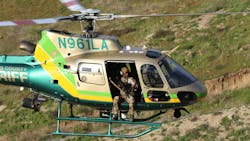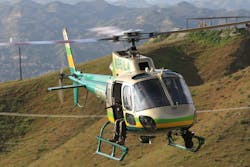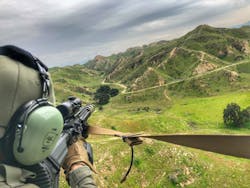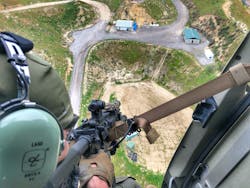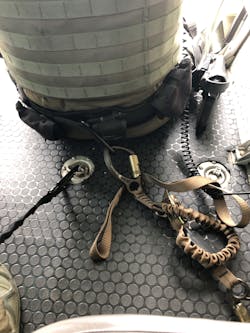An Effective Aerial Platform Operations Program
When aerial platform operations are mentioned in law enforcement circles, they usually inspire opinions in support or opposition. Some refer to it as APS (aerial platform shooting) and this conjures up the notion that it will only be deployed in a crisis or use of force incident. However, aerial platform operations (APO) is much more than that and is an operational capability between law enforcement helicopter units and SWAT units to provide overwatch on demand for any law enforcement incident that may be required and/or requested for the safety of citizens and law enforcement personnel.
APO is a specialized tool that can be proactively deployed and not just reserved for a response to a crisis. For most law enforcement agencies, it involves partnering different work groups together—specifically the helicopter and SWAT units. Bridging the gap between these groups that typically do not see each other every day into one that works seamlessly is not something accomplished overnight but through effective training.
Origins
Law enforcement aerial platform programs exist more in numbers than one would think. Found typically in larger law enforcement organizations around the country, the origins for each one may differ in how they came to be. For many, the basis of information on shooting a rifle from a moving helicopter was derived from military use and subsequently passed down through retired military personnel or military personnel who transitioned to law enforcement. For me, this began in such manner some 20 years ago and was derived from Ret. MSgt. Neil Morris (USMC). Neil brought formalized training to our agency and provided us with an additional option to assist in tactical operations. Even among a Tier 1 full-time SWAT team, many could not foresee the benefits of a trained SWAT operator in a helicopter. At the time there was literally no one in law enforcement teaching aerial platform shooting. Hence, why some agencies with helicopters did not even want to explore this as a tactical option. Agencies that operate aerial platform programs and have not received formal training are not necessarily doing it wrong but may be missing out on information that could be critical to improving overall performance and shot accuracy.
Formal training
An aerial platform use of force incident will be highly scrutinized whether it went well or not. A 2017 incident utilizing aerial rifle fire by the Los Angeles Police Department SWAT team while justifiable and ended the threat still faced scrutiny from a civilian review commission even after the chief of police publicly stated it was justifiable and correct. With aerial use of force incidents numbering five times since 1984 much public attention is garnered due to its use not being mainstream. Outside training instructors, from law enforcement or retired military, can provide much-needed insurance to evaluate your program for any improvements needed.
These programs should not be birthed by sending representatives to observe training from practicing agencies. Beginning an aerial platform program in this manner is irresponsible and fraught with countless liability and safety concerns. Best practices dictate that formal training from vetted instructors be conducted first before any operational deployments occur.
Programs should be looked at from a court defensible view. Where did it start? How did it start? Who provided the training? Where is the expertise derived from? Loosely run programs are more of a liability than an asset and should be evaluated for their ability to withstand scrutiny from the public and the court system.
Sustainment training
An agency should not venture down this road if they will not be able to maintain consistent training to reinforce concepts and techniques with both pilots and SWAT personnel. While the physical act of firing a rifle from a moving platform is not difficult, it is the other information that must be consciously applied until it becomes an unconscious act. That only occurs with training and then more training. Current sustainment training with various law enforcement agencies fielding APO programs can range from a maximum occurrence of once every two weeks to a low occurrence of once every three to four months (quarterly). Any less training of this specialty skill on the part of pilots, tactical flight officers (TFO’s) and SWAT personnel could lead to increased liability, scrutiny, and safety concerns when the use of force is utilized from this platform.
Aerial use of force incidents
- 1984, Alaska. An alone spree killer armed with a .30-06 rifle had murdered nine people in Manley Hot Springs, Alaska. Two helicopters with Alaska State Troopers onboard converged on the suspect’s location. The suspect was able to fire at one of the helicopters killing Trooper Troy Duncan aboard. Fortunately, Trooper Jeff Hall returned fire from the helicopter and hit the suspect multiple times killing them. Aircraft was a Bell Helicopter Jet Ranger 206.
- 2004, California. A recycling plant was under fire from a criminal sniper in Baker Canyon, Calif. When sheriff deputies responded to the 911 call, the suspect killed a deputy on arrival. The four-hour standoff ended when an Orange County Sheriff’s Deputy boarded a helicopter. During the search, the suspect fired on the helicopter injuring a Vietnam veteran pilot who applied a makeshift tourniquet and continued to fly for an additional hour. Deputy Chris Hays returned fire from the helicopter and hit the suspect multiple times. K9’s launched on the suspect, locating him where he was confirmed dead from the Deputy Hays shots. Deputy Hays credits his training in the military for resolving this incident. Aircraft was a McDonnell Douglas 600N.
- 2012, Texas. Texas Department of Public Safety (DPS) was requested to assist with a game warden who was in pursuit of a truck on the border. The helicopter caught up to the pursuit and was occupied with a DPS marksman in the rear. A decision to use force to shoot the tires was authorized and multiple shots were fired. Eventually successful in causing the truck to come to a stop, it was later learned that some rifle shots entered the pickup bed. The bed of the truck had a tarp obscuring what was beneath—three Guatemalan immigrants. Two out of three were killed. A tragedy involving the use of force from this platform, but further reinforces the need for increased training and oversight to prevent incidents such as this in the future. Aircraft was a Eurocopter ES350.
- 2015, California. A San Bernardino Sheriff’s Office, Calif. helicopter was following a vehicle pursuit of a home invasion suspect on the 215 highway. When the suspect began to drive the wrong way on the freeway a tactical flight officer (TFO) made the decision to use force and fired at the vehicle. The shots were successful in hitting the suspect who was driving. The suspect bailed from the vehicle and it continued in motion and collided with another vehicle occupied by a family. The family sustained injuries and the suspect died. Aircraft was a Eurocopter ES350.
- 2017, California. The Los Angeles Police Department responded to a 911 home invasion call. A lone suspect entered the residence and obtained weapons from the homeowner. Responding uniformed officers took fire on arrival and LAPD SWAT was requested to the scene. Due to the terrain and layout of the residence, APS was authorized. As the helicopter orbited the residence the suspect opened fire on the helicopter. SWAT Operators on TSOPS’s returned fire from the helicopter killing the suspect. Aircraft was a Eurocopter ES350.
Personnel selection
What methodology is used in determining which SWAT personnel should be selected and trained for aerial platform operations? A common question that may vary from team to team but usually comes down to entry or sniper personnel. Entry personnel can be successful in this role, but typically SWAT teams are only issued one carbine (223/5.56). If utilizing exterior benches (TSOP), then multiple rifles build in redundancy should a rifle fail to malfunction.
Rifles
The advent of the SBR (short barreled rifle) has become prevalent with most SWAT teams. These rifles are beneficial in typical SWAT environments. However, what is beneficial on the ground in close quarter areas is not necessarily beneficial at 150 feet in the air in a moving platform. Longer barrel length for rifle platforms is advantageous and optimized between 16” to 20” in length. The increased length allows the officer to maintain better control of the rifle and increased referencing of the helicopter skids and main rotors.
Of significant note is that SBR’s typically result in slower muzzle velocities. This is consequential in lag data information and the amount of distance in feet that must be applied. A slower muzzle velocity equates to a larger lag.
Suppressor use is strongly recommended in this platform as it reduces the felt overpressure and repeated decibel pounding the pilots receive during training iterations. SBR’s without suppression exhibit increased recoil jump thus incrementally increasing the time between shots.
The most common law enforcement rounds in use for APO are .223 Rem. and .308 Win. Larger caliber rifles (.338 Lapua Magnum and .50 BMG) can be effectively fired from helicopters if needed. If larger calibers are employed, then the training must involve those calibers. Optic solutions vary from red dot sights (EOTech, Aimpoint, etc.) which offer fast target acquisition and allow both eyes opened during firing. However, the myth that variable powered riflescopes are of no use in this platform is incorrect. At low power conducting specific target approaches at extended distances, the sniper riflescope can excel. With the advent of quality red dot/variable low-powered riflescopes (Nightforce NX8 or ATACR 1-8X) not only can one be effective in target engagement but with the increased magnification SWAT operators are able to observe more effectively during overwatch assignments that typical unmagnified red dot optics don’t provide.
Ammunition
Current ammunition for SWAT work should not be rubber-stamped for aerial platform use. Consideration should be given to terminal ballistics and projectile type/grain weight. For example, a .223 Rem projectile that weighs 55 grains and has a ballistic tip in composition may not be ideal for this platform dependent upon your area of operation. With the angle of the helicopter at altitude and shots typically directed downward heavier projectiles may be advantageous.
An examination of history represents that of the five incidents involving use of force, two involved suspects inside vehicles and three involved open or wooded areas. There is no magic bullet. Bonded, monolithic or steel core rounds may be advantageous in this platform for a well-versed selection of projectiles if needed. As always, each agency should evaluate terminal ballistics and projectile performance in their weapon systems balanced with their area of operation.
Ancillary aids
Interior shooting can be enhanced utilizing a sling like the TAB Gear Aerial Platform Sling. Developed by myself and the manufacturer over the span of a year, the intention was to produce a one-piece sling that would support a variety of rifles and anchor into natural hard points found in each of the three aircraft manufacturers. With the rifle supported on the front end and having unimpeded lateral travel on the sling, accuracy is increased through applying rearward pressure through the buttstock into the sling as the incorporated flat bungee attenuates the aircraft vibration resulting in a more stable sight picture.
Securing SWAT personnel into the aircraft is of the utmost importance when deploying APO. This is easily achieved through the use of the Yates Gear Rappel Master Adjustable Lanyard. The adjustability of the lanyard allows personnel to adjust one-handed during flight as needed and still maintain positive control of their rifle. The lanyard is available with two styles of carabiners to adapt to a variety of hard anchor points inside the aircraft. The lanyard can be attached in front of or behind the operator.
Practice, practice, and verify
Verification of skills should be conducted during each training session. This can be accomplished through observation of personnel’s ability to self-load into the aircraft under time constraints and perform all designated target approaches without aid. It can be further enhanced through a designated qualification course of fire from the helicopter. Agencies should document aerial platform training each time and establish training objectives during for each session. A well-versed program evaluates everyone as each individual has a role and purpose for successful deployments.
An effective APO program is dependent upon the full unequivocal buy-in from pilots, SWAT, and administration. All personnel involved must share the common goal of providing a solution from the air to address vehicle pursuits, elevated criminal sniper attacks, vehicle-borne improvised explosive devices, active killers, etc.
Furthermore, deploying APO proactively at large scale events and mobile events goes to further showcase the capabilities in safeguarding our public which we have all been sworn to protect. Treading lightly into APO without formal training or a firm base and knowledge and then failing to sustain training could prove to be catastrophic. We owe it to ourselves, our families, our agencies and most importantly the public we protect to get it right with an effective aerial platform program that will sustain longevity and increased officer and public safety on the ground.

Mark Lang
Mark Lang is the Director of Sniper Training for Tacflow Academy. Nearing a 30-year career in law enforcement he has spent a majority of it as a member of a Tier 1 Full-time SWAT team in North Texas. He has developed proprietary training curriculum in the areas of Public Venue Response & Deployment, Large Caliber Rifle Instructor and Aerial Platform Operations. A member of the America Sniper Association and the National Tactical Officers Association Sniper Section Committee he writes and contributes to several media outlets to increase awareness for police snipers, SWAT personnel & SWAT Supervision. He is also the CEO of Venue Safety Consulting and can be reached at [email protected]
